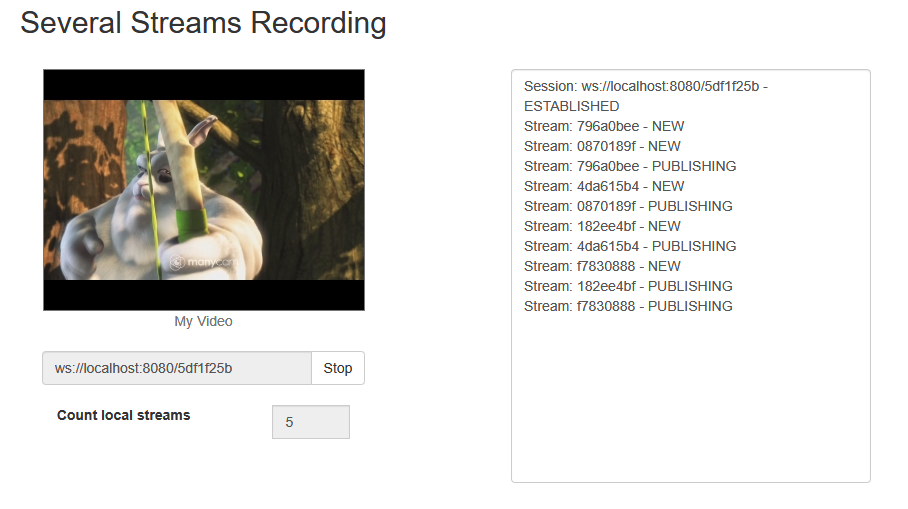Several Streams Recording¶
Example of streamer with recording of several published video streams in one session¶
This streamer can be used to publish and record several WebRTC streams simutaneously to Web Call Server in one session.
This example does not work in iOS Safari. It is recommended to use desktop PC/Mac browser.
On the screenshot below 5 streams are publishing and recording

Code of the example¶
The path to the source code of the example on WCS server is:
/usr/local/FlashphonerWebCallServer/client2/examples/demo/streaming/several_streams_recording
- several_streams_recording.css - file with styles
- several_streams_recording.html - page of the streamer
- several_streams_recording.js - script providing functionality for the streamer
This example can be tested using the following address:
https://host:8888/client2/examples/demo/streaming/several_streams_recording/several_streams_recording.html
Here host is the address of the WCS server.
Analyzing the code¶
To analyze the code, let's take the version of file several_streams_recording.js with hash ecbadc3 which is available here and can be downloaded in build 2.0.212.
1. Initialization of the API¶
Flashphoner.init() code
2. Connection to server.¶
Flashphoner.createSession() code
testSession = Flashphoner.createSession({urlServer: url}).on(SESSION_STATUS.ESTABLISHED, function (session) {
...
}).on(SESSION_STATUS.DISCONNECTED, function (session) {
...
}).on(SESSION_STATUS.FAILED, function (session) {
...
});
3. Receiving the event confirming successful connection¶
ConnectionStatusEvent ESTABLISHED code
testSession = Flashphoner.createSession({urlServer: url}).on(SESSION_STATUS.ESTABLISHED, function (session) {
addSessionStatusLog(session);
//session connected, start playback
publishStreams(session);
}).on(SESSION_STATUS.DISCONNECTED, function (session) {
...
});
4. Video streaming¶
Session.createStream(), Stream.publish() code
When stream is created, the following parameters are passed
streamName- name of the streamlocalVideo-divelement, in which video from camera will be displayedrecord: true- to enable stream recording
Every stream is added to streams array
var stream = session.createStream({
name: streamName,
display: localVideo,
record: true,
receiveVideo: false,
receiveAudio: false
...
});
addStatusLog(stream);
stream.publish();
streams.push(stream);
5. Receiving the event confirming successful streaming¶
StreamStatusEvent PUBLISHING code
var stream = session.createStream({
...
}).on(STREAM_STATUS.PUBLISHING, function (stream) {
checkCountStreams();
addStatusLog(stream);
...
});
6. Streams count checking and publishing new streams until desired value is reached¶
function checkCountStreams() {
var $publishBtn = $("#publishBtn");
if ($publishBtn.text() === "Start" && $publishBtn.prop('disabled') ) {
if (streams.length < $("#countStreams").val()) {
publishStreams(session);
} else {
toRecordedState();
}
}
}
7. Streaming stop¶
Stream.stop() code
function toRecordedState() {
$("#publishBtn").text("Stop").off('click').click(function () {
for (var i in streams) {
streams[i].stop();
}
streams = [];
toInitialState();
}).prop('disabled', false);
}
8. Receiving the event confirming successful streaming stop¶
StreamStatusEvent UNPUBLISHED code